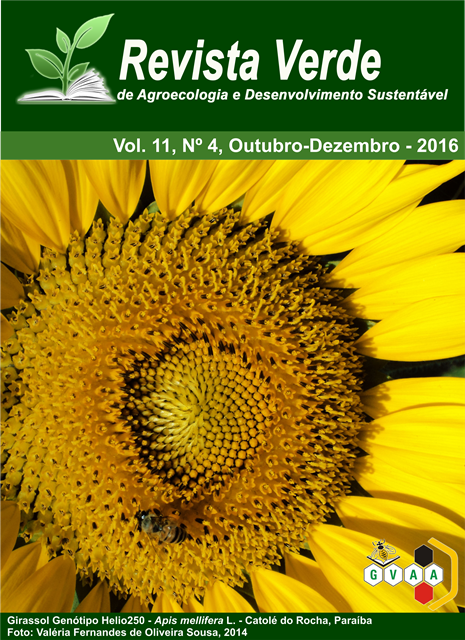Acúmulo e translocação de cobre e zinco em plantas de Crambe abyssinica
DOI:
https://doi.org/10.18378/rvads.v11i4.4539Keywords:
Culturas energéticas, metais pesados, oleaginosa.Abstract
Crambe (Crambe abyssinica) é uma cultura promissora para a produção de biodiesel. No entanto, não há muita informação disponível sobre as técnicas e pesquisas sobre o melhor desempenho em diferentes regiões para explorar o seu potencial. Objetivou-se avaliar o efeito de cobre e zinco no acúmulo e distribuição destes elementos nesta planta. O estudo foi realizado em casa de vegetação e constou de dois experimentos independentes, em delineamento experimental inteiramente casualizado, com três repetições. Em um deles, os tratamentos consistiram em cinco doses de cobre, ou seja, 0, 10, 15, 20 e 25 mg kg-1 e no outro , cinco doses de zinco, 0, 20, 30, 40 e 50 mg kg-1. Após 100 dias de germinação as plantas foram colhidas e avaliadas os níveis de cobre e zinco em tecidos de plantas. Os dados foram submetidos à análise de variância e comparação de médias pelo teste de Tukey a 1 e 5% de significância. Os teores de cobre e zinco aumentaram significativamente na fitomassa do crambe em função da aplicação destes elementos no solo. Os acúmulos de cobre e zinco nas plantas de crambe obedeceram às seguintes ordens, respectivamente: raiz > parte aérea; parte aérea > raiz. O índice de translocação do zinco foi maior que a do cobre nas plantas de crambe.
Content and translocation of copper and zinc in plant Crambe abyssinica
Abstract: Crambe is a promising crop for biodiesel production. However, there is no much information available about techniques and research regarding the best performance in different regions to explore its potential. The objective of this study was to evaluate the effect of copper and zinc in the accumulation and distribution of these elements in this plant. The study was carried out in a greenhouse and it consisted of two independent experiments in completely randomized design, with three replications. Two metals with five levels were applied: 0, 10, 15, 20 and 25 mg∙kg−1 for copper and 0, 20, 30, 40 and 50 mg∙kg−1 for zinc. After 100 days of germination the plants were harvested and assessed the levels of copper and zinc in plant tissues. Data were subjected to analysis of variance and comparison of means by Tukey test at 1 and 5% significance. Copper and zinc content increased significantly in the biomass of crambe due to the application of these elements in the soil. Copper and zinc accumulation in crambe plants followed the following orders, respectively: root> shoot; shoot> root. The zinc translocation ratio was higher than that of copper in crambe plants.















